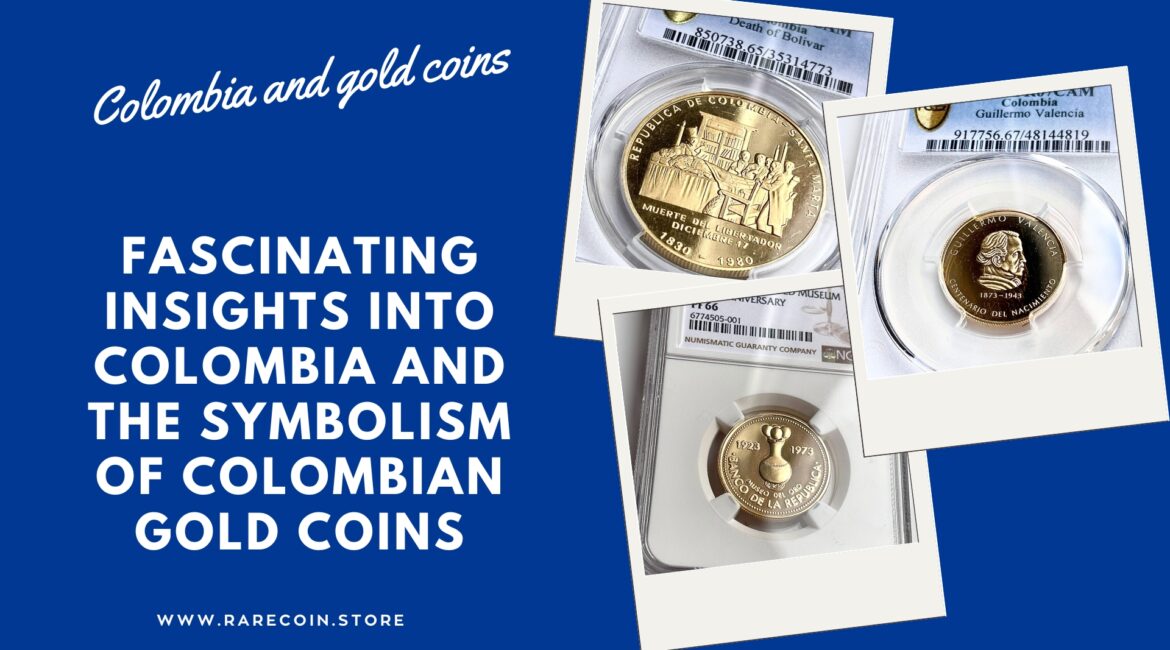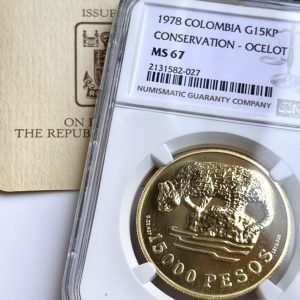Not only is Colombia distinguished by its rich natural resources, modern cities and diverse culture, but it has also made significant progress in recent years in securing peace with revolutionaries, reducing crime and protecting its robust democratic institutions. These developments contribute significantly to a growing economy. Below are some fascinating facts about Colombia.
Biodiversity and population
Colombia, as the second most biodiverse country in the world, surpassed only by Brazil, which is ten times larger, is one of the 17 “megadiverse” countries and has the highest biodiversity per unit area. This diversity includes more bird species than all of Europe and North America combined.
The population of Colombia is 52,216,262 people at the beginning of 2024. The capital district of Bogotá, with a population of 11,658,211, not only functions as the largest urban center in the country, but also houses the most important financial and cultural hub.
The country’s official name is Republic of Colombia and is derived from the surname of the explorer Christopher Columbus. It is important to emphasize that the correct pronunciation is “Col-o-mbia” and not “Col-u-mbia” as it is often incorrectly pronounced by non-Spanish speakers.
The Colombian flag
The Colombian flag is a profound symbol of national pride and identity. It includes three horizontal stripes, each color having symbolic meaning:
- Yellow : The dominant upper stripe represents the fertility of Colombia’s soil and its rich natural resources, particularly gold.
- Blue : The stripe positioned in the center represents the two oceans, the Caribbean Sea and the Pacific Ocean, that hug Colombia. It also reflects the vastness of the sky above the country.
- Red : The lower red stripe, another quarter of the flag’s height, embodies the courage, resilience and heroism of the Colombian people. Furthermore, it is a moving symbol of the blood shed during the struggle for independence.
Curious facts
- Colombia is the only South American country with coastlines on the Pacific Ocean and the Caribbean.
- Colombia is home to pink dolphins in the Amazon, locally known as “boto”. These freshwater dolphins, with their distinctive pink color, fascinate and inspire local legends.
- The region that now constitutes Colombia was originally inhabited by indigenous tribes such as Muisca, Quimbaya and Tairona. In 1499 the Spanish came and colonized the area, which they called New Granada.
Culture, sport and music
- Colombia is the world’s second-largest exporter of flowers, with the United States ordering 4 billion roses each year, a significant portion of which are destined for Valentine’s Day. Due to its equatorial location, Colombia produces some of the world’s straightest rose stems and has more than 4,000 species of orchids.
- Colombia’s traditional national sport is Tejo, a team sport that involves hurling heavy metal discs into clay pools adorned with gunpowder landmines, all while drinking copious amounts of local beer. Soccer is the most popular sport, and the Colombian national team won the Copa América (South American Championship) in 2001.
- In Colombia, it is mandatory for radio and public television to play the national anthem every day at 6 a.m. and 6 p.m.
- Colombia has a vibrant music scene, with well-known musicians such as Shakira and Juanes achieving international fame.
Natural beauties and traditions
Colombia is home to the Cano Cristales, known as the “River of Five Colors” or the “Liquid Rainbow.” Located in the province of Serranía de la Macarena in Meta, this natural wonder undergoes a fascinating color transformation from late July to November that includes yellow, green, blue, black and especially red.
Colombian culture places an extraordinary value on age and older people are treated with deep respect throughout the country. As a person ages, their voice becomes more influential, reflecting a deep-rooted appreciation for the experiences and wisdom of older generations.
Culinary delights and other facts
In Colombia, the national drink is aguardiente, a liqueur distilled from sugar cane. Due to its sweet taste, it is best enjoyed pure.
Bandeja Paisa, Colombia’s culinary masterpiece, goes beyond a simple dish; it presents itself as a sumptuous banquet that captures the essence of Colombia’s rich culinary tradition. This dish from the Antioquia region is a convincing testament to the Colombian passion for tasty and filling meals.
Nature and economy
- The Sierra Nevada de Santa Marta in Colombia, at an elevation of 13,000 m, is the highest coastal mountain range in the world and has shifted more than a thousand miles over the last 170 million years.
- Colombia is the world’s largest producer of emeralds and the third largest exporter of coffee after Brazil and Vietnam.
- The ocelot , whose image appears on some Colombian coins, is a small wild cat known for its distinctive black spots and stripes, round ears, and white neck and belly areas. It is nocturnal and territorial, excellent at climbing, jumping and swimming.
Cultural and historical treasures
The Gold Museum (Museo del Oro) in Bogotá , Colombia, is a renowned archaeological museum and one of the country’s top tourist attractions. It presents an extensive collection of pre-Columbian gold and metal alloys, including tumbaga, and houses the world’s largest selection of gold artifacts.
In 1973, a proof-quality gold coin with a face value of 1500 pesos was minted in Colombia to honor the Gold Museum of the Central Bank of Bogotá . The total circulation of this coin was 50,000.
A Eucharistic Congress in the Catholic Church brings together clergy, religious and lay people who together bear witness to the important teaching of the real presence of Jesus in the Eucharist. These gatherings, which bring together people from different regions, typically include extensive outdoor masses, Eucharistic Adoration (Holy Sacrament), and other devotional celebrations that take place over several days. An outstanding example of this is the 39th International Eucharistic Congress, which took place in Bogota in 1968.
Pope Paul VI personally chose Bogota DC as the venue for this congress after visiting the Colombian capital. This congress was the third ever held in a Spanish-speaking country and the first hosted by Colombia. The list of participants included bishops, archbishops, cardinals, clergy and faithful from Latin America and around the world.
The main focus of the congress was the global renewal of the Catholic Church, particularly in Colombia, which was experiencing significant economic and social recovery at the time. This upswing was the result of the economic boom in the middle of the 20th century. As a country in the process of industrialization and modernization, Colombia embodied the profound social and economic changes that were taking place around the world. With this awareness, Bogota was chosen as the venue for the International Eucharistic Congress of 1968.
This year the 200 Pesos gold coin was also minted in proof quality in honor of the 39th International Eucharistic Congress . This coin from Colombia has a mintage of only 8,000 pieces.
Guillermo Valencia Castillo and Simón Bolívar on gold coins
- Guillermo Valencia Castillo (October 29, 1873, Popayán, Colombia – July 8, 1943, Popayán) was an outstanding Colombian poet, translator and politician. A pioneer of modernism in Colombia, Valencia was a member of the Conservative Party of Colombia. In his political career he sought the presidency twice, in 1918 he was defeated by Marco Fidel Suárez and in 1930 he lost the presidential election against the liberal Enrique Olaya Herrera. Valencia left a lasting legacy, including five children, including Guillermo León Valencia, who served as President of Colombia from 1962 to 1966. 1973 was in honor of Guillermo Valencia’s 100th Birthday a limited gold coin embossed.
- Simón José Antonio de la Santísima Trinidad Bolívar Palacios Ponte y Blanco (July 24, 1783 – December 17, 1830) was a Venezuelan military and political figure who played a crucial role in achieving the independence of the present-day countries of Colombia, Venezuela, Ecuador, Peru, Panama and Bolivia were played by Spanish colonial rule. Known as El Libertador, or the Liberator of America, Bolívar was awarded a gold coin to commemorate his 150th birthday. anniversary of death honored. Minted in 1980, the 30,000 peso bolivar 1-ounce gold coin honors Bolívar as a revered national hero and key figure in the independence movements of numerous South American nations.
Discover our exclusive collector coins from Colombia for you here:
-
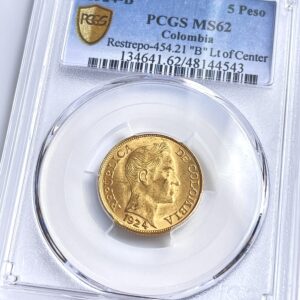
Colombia – 1924 – 5 Pesos – B Lt of Center – 7.33g – PCGS MS62
695,00 €plus shippingDelivery Time: approx. 2-3 days (excluding Saturdays, Sundays and public holidays) -
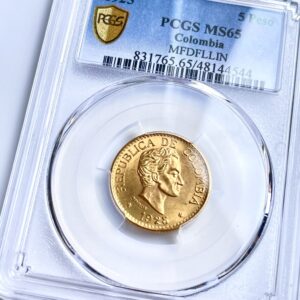
Colombia – 1925 – 5 Pesos – MFDFLLIN – 7.33g – PCGS MS65 (48144544)
650,00 €plus shippingDelivery Time: approx. 2-3 days (excluding Saturdays, Sundays and public holidays) -
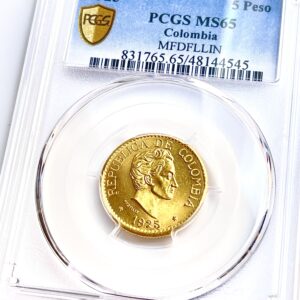
Colombia – 1925 – 5 Pesos – MFDFLLIN – 7.988g – PCGS MS65 (48144545)
650,00 €plus shippingDelivery Time: approx. 2-3 days (excluding Saturdays, Sundays and public holidays) -
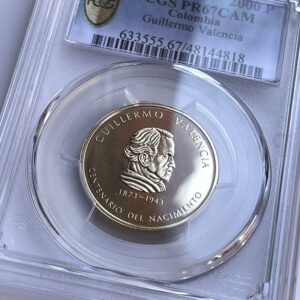
Colombia – 1973 – 2000 Pesos – 100. Birthday Guillermo Valencia – 11,6g – PCGS PR67 CAM
975,00 €plus shippingDelivery Time: approx. 2-3 days (excluding Saturdays, Sundays and public holidays) -
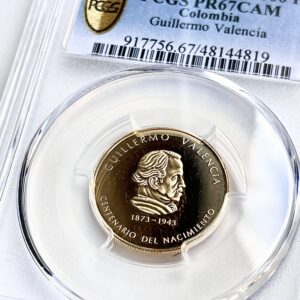
Colombia – 1973 – 1500 Pesos – 100. Birthday Guillermo Valencia – 7.74g – PCGS PR67 CAM
795,00 €plus shippingDelivery Time: approx. 2-3 days (excluding Saturdays, Sundays and public holidays) -
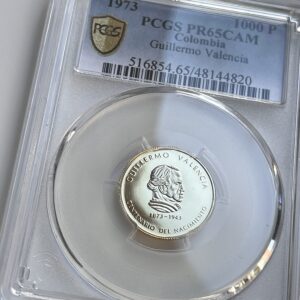
Colombia – 1973 – 1000 Pesos – 100. Birthday Guillermo Valencia – 3.78g – PCGS PR65 CAM
495,00 €plus shippingDelivery Time: approx. 2-3 days (excluding Saturdays, Sundays and public holidays) -
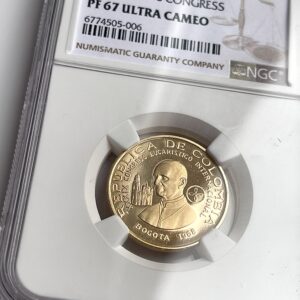
Colombia – 1968 – 200 Pesos – International Eucharistic Congress – 7.74g – NGC PF67 Ultra Cameo
725,00 €plus shippingDelivery Time: approx. 2-3 days (excluding Saturdays, Sundays and public holidays)

